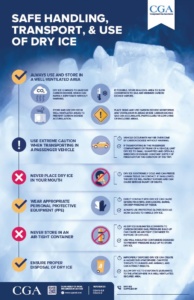
Dry ice is extremely cold (−109.3 °F / −78.5 °C) and rapidly sublimates, or converts, into carbon dioxide gas at room temperature. It is critical that users read and follow the instructions and safety precautions provided by their dry ice supplier.
Anyone who handles dry ice should be aware of its unique properties and potential hazards. These include the extremely cold temperature, potential to create an oxygen-deficient atmosphere, and rapid conversion from a solid to gas. This safety poster, provided by the Compressed Gas Association at no charge, provides basic safety information for the handling, transport, and use of dry ice.
For more information about Dry Ice Safety or to access CGA’s free Safety Poster, click here.
CGA also has the following safety posters available at no charge:





